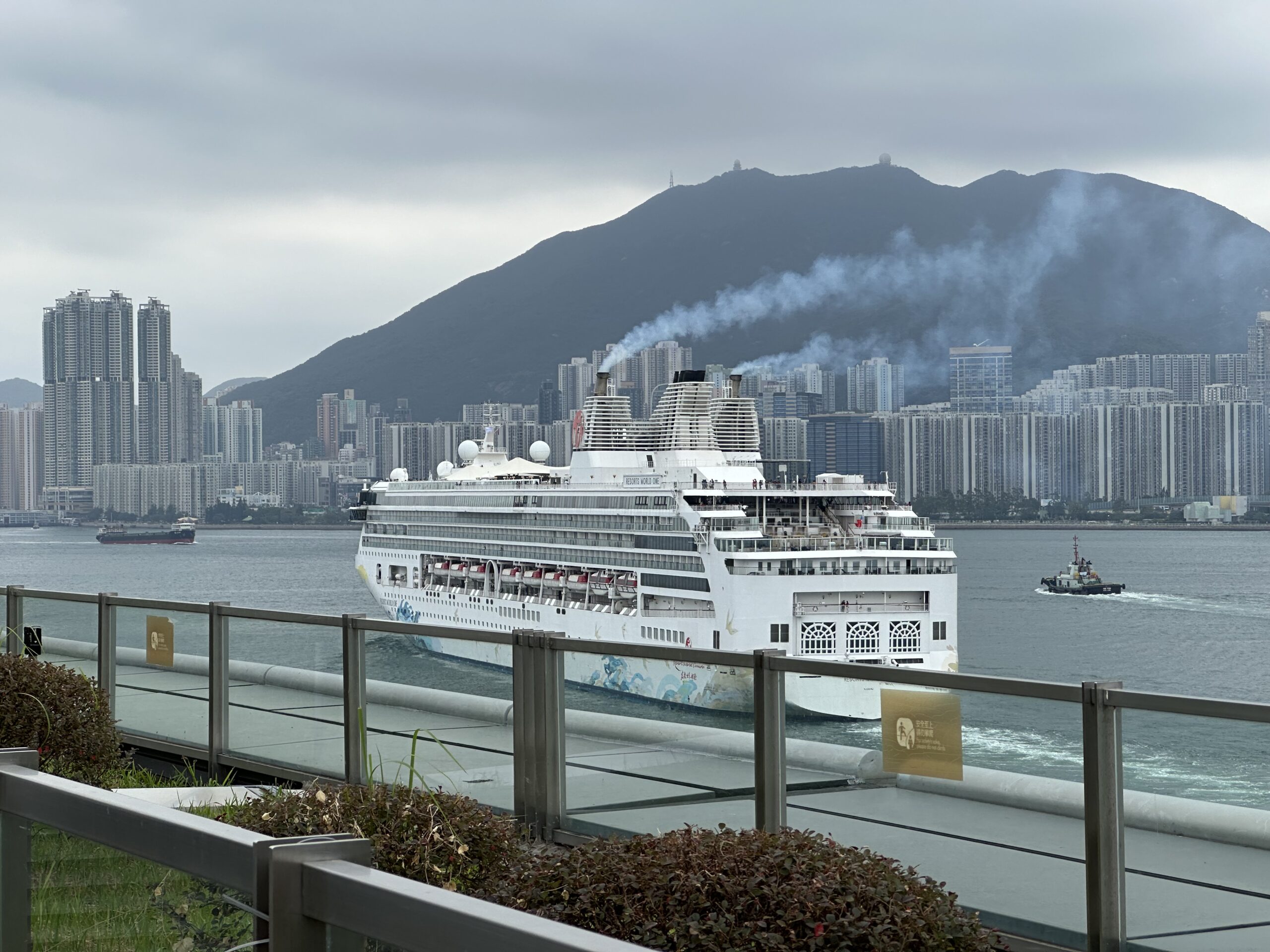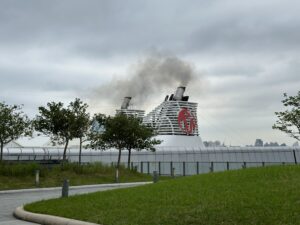
Cruise ship emissions cause hazardous NO2 levels
As announced in the Chief Executive’s 2023 Policy Address, an official action plan on the development of cruise tourism economy is scheduled to be published in the first half of 2024. However, the latest findings of Clean Air Network (CAN) suggests that cruise ships docked at Kai Tak Cruise Terminal have been emitting hazardous levels of nitrogen dioxide (NO2) – with one vessel at berth, the concentration level of NO2 in the air exceeded the World Health Organization (WHO) standards by almost 9 times, endangering public health. CAN urges the government, while formulating plans for cruise tourism, to develop shore power facilities in order to reduce emissions, protect the environment and public health, and strengthen Hong Kong’s competitiveness as an international cruise hub.
The unfulfilled promise of shore power
For road vehicles, idling engines are banned by law in Hong Kong to reduce roadside emissions; but for cruise ships at berth, switching off their engines is currently not an option.
Cruise ships basically operate as hotels, with a need for continuous power supply to maintain their facilities, even when they are docked. As such, cruise ships generate power with the fuel on board, producing immense air pollution and carbon emissions. Research has found that a single cruise ship docked for a day can emit exhausts equivalent to 34,400 idling tractor-trailers.
If a terminal is equipped with shore power facilities, cruise ships can be connected to onshore power sources and run on electricity, ceasing to emit pollutants directly. According to a study by the U.S. Environmental Protection Agency, shore power can help reduce emissions of nitrogen oxides (NOx) from ships by up to 98%.
Navigation is the major source of NOx in Hong Kong, accounting for 36% of the total emissions in 2020, followed by power generation (24%) and road transport (19%). Reducing emissions from the two cruise terminals in Hong Kong, Kai Tak Cruise Terminal and Ocean Terminal in Tsim Sha Tsui, where hundreds of ships berth each year will help diminish NOx emissions in Hong Kong significantly.
In fact, during the construction of Kai Tak Cruise Terminal, the government had already reserved a location for shore power facilities. The plan was reiterated by the then Chief Executive C.Y. Leung in the 2013 Policy Address. However, in 2015, after a feasibility study suggested the costs for constructing and maintaining the shore power facilities would be $315 million and $14 million annually respectively, the government decided to shelve the plan citing that only a small number of cruise vessels were able to connect to shore power, which would affect its cost-effectiveness.
Shore power as an international trend
After nearly a decade, reduction in pollution and carbon emissions has become a common goal across the globe. The shipping industry is also taking steps to go green – the International Maritime Organization (IMO) has incorporated in its strategy the target to reach net-zero emissions from international shipping close to 2050.
Cruise Lines International Association (CLIA), the world’s leading cruise trade association, states that nearly half of the vessels in their members’ fleets are already equipped to connect to shoreside electricity, with the proportion rising to 72% by 2028, representing 74% of global passenger capacity. CLIA also committed to having all vessels calling at ports providing shore power to be equipped to use shore power by 2035. Many of the members of CLIA regularly berth their vessels in Hong Kong.
Targets for the development of shore power has been set in different parts of the world. The Ministry of Transport of the People’s Republic of China envisions to equip all cruise terminals with high-voltage shore-side power facilities by the end of 2024.
The European Union Council is requiring all maritime ports to provide shore-side electricity for vessels by 2030, and passenger ships and container ships docking at major ports to use shore power by 2030. In addition, since 2010, California, U.S., has started to mandate in phases cruise ships to connect to shore power.
Moreover, with the growing environmental consciousness in society, tourists and residents are now more concerned about the impact of tourism on local communities. The idea of responsible tourism emerged in recent years, highlighting the importance of minimising the negative impact of tourism on the environment. As cruise tourism is being criticised for causing massive pollution, the Hong Kong government, while laying out the said plans, should take action to diminish the damages to the environment and public health, in order to provide tourists with a sustainable travel option.

Findings of air quality monitoring
In November 2023, CAN monitored the air quality in the Kai Tak Cruise Terminal Rooftop Park to compare pollution levels with and without cruise berthing. The results are as follows:
| Date | Time | With/without cruise berthing | Average concentration of NO2 (µg/m³) |
| 7 Nov, 2023 | 11am – 1pm | Without cruise berthing | 24.5 |
| 8 Nov, 2023 | 11am – 1pm | One cruise ship berthing | 96.1 |
Nitrogen dioxide (NO2) is a nitrogen oxide that irritates the eyes, nose, throat and respiratory system, causing symptoms such as coughing, wheezing and shortness of breath, worsening the condition of asthma and respiratory illnesses. Long-term exposure to NO2 will also weaken lung function and immunity to respiratory diseases.
As indicated in the air quality monitoring results, the average NO2 concentration in the Rooftop Park was significantly higher when there was one cruise ship at berth than when there was no cruise ship docked, with a difference of nearly three times.
With one cruise ship docked, the NO2 concentration was as high as 96.1 µg/m³, exceeding the annual average standard (10 µg/m3) set out in the WHO Global Air Quality Guidelines by almost nine times.
According to the schedule of the terminal, a total of 136 vessels berthed in 2023, with an average stay of 10.3 hours. Throughout the year, there were 12 days on which two vessels were docked at the terminal simultaneously, which may double the hazardous emissions.
Endangering community well-being
Emissions from cruise ships immensely affect the wellbeing of the neighbouring communities. As Kai Tak is one of the major development areas, the residential and working population in the district is expected to be hundreds of thousands. In the former runway area of the Kai Tak Airport, where the terminal is located, there are 11 residential sites – residents of these areas will be exposed to dangerous levels of pollution if no action is taken, impairing their physical and mental health.
On the other hand, the Hong Kong Children’s Hospital is less than one kilometre away from the terminal. Air pollution is particularly harmful to children because their bodies are still developing and they have weaker immunity systems. Also, they may inhale more pollutants as they breathe faster than adults. For those who are visiting the hospital, their health is even more fragile. It is therefore necessary to ensure a safe and healthy environment around the hospital.
The Kwun Tong Promenade, which is located just across the harbour from the pier, is a popular spot among visitors and joggers. Unfortunately, emissions from cruise ships are putting these people in danger. As people breathe faster during exercise, working out near the source of air pollution is especially harmful.
Policy recommendations
To protect public health, reduce emissions, and enhance the competitiveness of Hong Kong’s cruise terminals, CAN proposes the government to:
1. Re-launch the plan to install shore power facilities at Kai Tak Cruise Terminal and study the feasibility of providing shore power at Ocean Terminal.
2. Formulate a policy to require cruise ships berthing in Hong Kong to use shore power.
3. Install devices at cruise terminals to monitor air pollution levels and make public the real-time data.
4. In the long run, increase the proportion of renewable energy in the supply of electricity to shore power facilities so as to achieve emission reduction targets.

